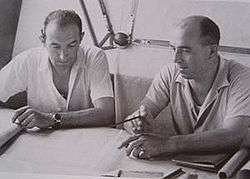Gioacchino Colombo

Gioacchino Colombo[1] (1903–1988) was an Italian automobile engine designer.
Early life
Colombo was born in Legnano. He began work as an apprentice to Vittorio Jano at Alfa Romeo.
Career
In 1937, Colombo designed the 158 engine for the Alfetta and caught the attention of Enzo Ferrari. Ferrari asked Colombo to design a small V12 for use in the new Ferrari marque's racing and road cars. The first Ferrari-Colombo engine appeared on May 11, 1947. Colombo's great work for Ferrari was a tiny 1.5 L V12, first used in the Tipo 125, 159, and then 166 sports cars. This engine, known in Ferrari circles as the "Colombo engine", was produced for road cars and endurance racing cars for more than 15 years in displacements up to 4.8 L. These included the famed 3.0 L Ferrari 250 racing, sports, and GT cars.
Colombo's engine was not as successful in Formula One racing. After stunning early success in the 166, the engine was supercharged for use in Formula One but failed to perform well. Ferrari hedged his bets, as he often did, by bringing on competing designer Aurelio Lampredi to create a large naturally aspirated V12, which replaced Colombo's. Later, Colombo's former mentor, Vittorio Jano, came to Ferrari and displaced the work of both men.
Colombo left Ferrari in 1950 and returned to Alfa Romeo. Here, he oversaw the company's racing efforts, including the success that year of Nino Farina and, in 1951, Juan-Manuel Fangio. In 1953, Colombo turned to Maserati and created the 250F Grand Prix car. Two years later, Colombo headed to newly restarted Bugatti to work on the 251. He then worked for MV Agusta in 1957-1970.[2]
Death
Colombo died in Milan in 1988.
References
- ↑ Spelled alternately as «Gioachino»
- ↑ Fox (2012-02-05). "Prottegisti in Ferrari". Modelfoxbrianza.it. Retrieved 2012-06-23.
